In the 1950’s and 60’s, the world had rocket fever. Humankind was taking its first steps into space and had sights on the moon. Kids could build rockets at the kitchen table and launch them in the schoolyard. On the darker side, the arms race was well underway with the US and USSR trying to close the fictional missile gap.
All around the world, engineers were trying to do new things with rockets. Among these were Robert Mainhardt and Arthur T. Biehl, who thought rockets could be useful as small arms. Together they formed MBA (short for Mainhardt and Biehl Associates), with an eye toward future weapons – – specifically rocket bullets.
The first project they worked on was the Finjet. Tiny (1 to 3mm diameter) needle-like rockets with steel tips. The rockets were made of injection molded plastic. There were plans to make them of soluble or flammable materials such that fired rockets would eventually burn up or dissolve in a victim’s body fluids. A magic bullet that did damage and disappeared, leaving no trace behind. If this sounds like something 007 would use, you’re not far off. MBA weapons were featured prominently in the James Bond movie “You Only Live Twice” It wasn’t the Finjet which made the screen though, it was their later design, the finless Gyrojet.
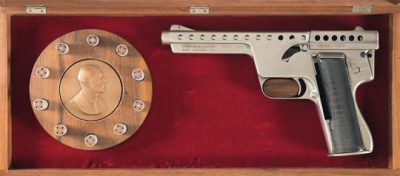
The Gyrojet is a cartridge which at first blush looks looked much like a .45 caliber pistol round. A Gyrojet is one piece though – unlike the bullet/shell combination of a standard round. Looks are where the similarities end. Conventional bullets are propelled down the barrel of a gun by an explosion. Gyrojets are powered by onboard rocket fuel. This means the gun itself can be much simpler, as the barrel and chamber don’t have to contain an explosion. Anyone who has shot off a bottle rocket knows that a simple rocket isn’t very accurate. To handle this, Gyrojets are spin stabilized — angled rocket nozzles would spin the bullet up to rotational speeds higher than most rifle rounds. While they may sound a bit like child’s toy rockets, these were definitely deadly weapons. At maximum speed, a Gyrojet round had twice the kinetic energy of a .45 ACP round it resembled.
Rocket Launchers
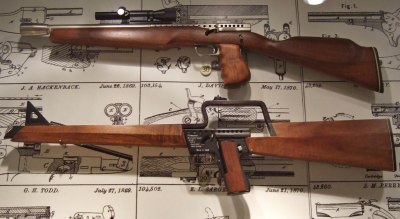
Gyrojets were different enough that they required their own firearms to launch. MBA produced several models, including a pistol, carbine, and rifle. These weapons were much lighter than their conventional counterparts and utilized smooth barrels. The chamber and barrels weren’t sealed — in fact they had holes, which allowed the rocket exhaust to eject out the side of the weapon.
An especially interesting design feature common to all the Gyrojet launchers is the hammer itself. When you pull the trigger on a conventional weapon, a firing pin is thrust forward into the rear of the cartridge, which is held in place in the breach of the gun. The Gyrojet does just the opposite: the hammer hits the front of the Gyrojet, forcing the entire projectile back into a fixed firing pin. The pin would hit the primer and ignite the solid rocket fuel. The hammer now does its second job of holding the round in place while thrust builds up. It only takes a few fractions of a second. Eventually, the Gyrojet has enough thrust to push the hammer out of the way, cocking the weapon for the next shot. The projectile then continues on its way, spinning out of the barrel and off into the distance. This, of course, meant the Gyrojets were semi-automatic and could be fired as quickly as the shooter could pull the trigger.
Machining Solid Rocket Fuel
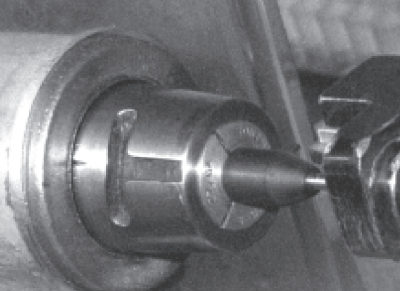
Gyrojets used solid rocket fuel, much like Estes rockets, and the Space Shuttle solid rocket boosters. The fuel itself was a double-base nitrocellulose/nitroglycerin mixture. The same fuel used in bazookas and other military rockets. The solid fuel arrived at MBA as a hollow stick. The sticks were cut, then machined down to fit the cone of the Gyrojet noses on a doweling machine and a lathe. Yes, you read that right. MBA was machining rocket fuel on a lathe. With careful control of feeds and speeds, it can be done safely, though it really isn’t something you would want to try at home. I just hope they cleaned out the lathe’s chip tray before anyone cut metal on it.
Getting the fuel to ignite and burn reliably was always a problem. Gyrojets used a normal primer, much like conventional bullets. Behind that bullet though, was a piece of flash paper or cotton which ran the length of the hollow fuel grain. The primer would ignite the cotton which would ignite the entire inner surface of the fuel grain. The fuel would then burn from the inside out.
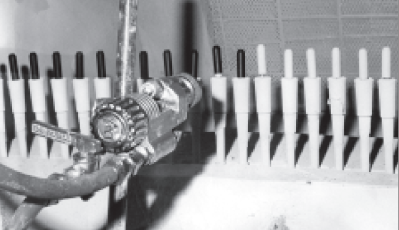
With rocket fuel sitting inside a thin metal casing, one would want an insulator to ensure the outside surface of the fuel grain didn’t ignite and burn through the casing. MBA tried many chemical compositions for this, but found titanium oxide to work best. In a clever hack, they simply went down to the local paint store and bought the white paint which had the most titanium oxide. It happened to be Moore’s Number Eight. The paint was sprayed on the fuel grain, which was then inserted into the casing. The titanium oxide worked so well that other rocket companies began asking MBA how they were doing it. The answer was simple – head down the local paint store!
Iterating on Nozzle Design
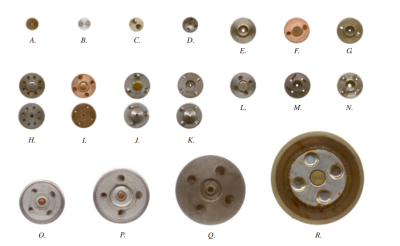
The key to the Gyrojet’s spin stabilization was its nozzles. They were also the toughest part to manufacture. MBA tried many designs, from crimped casings to fluted vanes. The design that won out was a series of precise holes in the rear of the casing. The holes were tapered, acting as rudimentary de Laval nozzles.
Tapered drill bits aren’t very common, so MBA had to have them custom made. The holes also had to be drilled precisely across from each other, at a very accurate angle. MBA created a fixture called Bertha. It consisted of a rotary table mounted on a drill press at an angle. This allowed the angle to be precisely controlled and two, four, or more holes to be drilled accurately. Even with this fixture, any misalignment of the nozzle holes would cause the bullet to fly poorly.
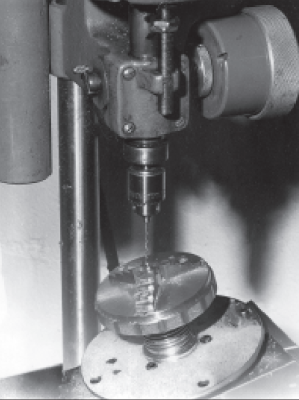
Bertha was eventually replaced with a custom automatic drilling machine, but the drilled holes weren’t the last word on the Gyrojet. MBA began experimenting with sintered powdered metal. Mainhardt believed these were the most accurate of all the Gyrojet nozzles made. One can only assume that sintered nozzles would have become the standard if MBA had gone into full production.
The Fizzle of the Gyrojet
While they were innovative, Gyrojet never caught on in a major way. The the two primary downsides were muzzle speed and accuracy. A Gyrojet projectile would be deadly at 40 feet. But out of the barrel of a pistol, it might not even have enough momentum to pierce the skin. That’s not to say that getting hit point blank by a Gyrojet would be pleasant — bruises or broken bones were quite possible. But it chances are it would go much better for the target than being hit point blank by a conventional bullet.
The other problem was accuracy. Since the Gyrojet left the barrel at such a slow speed, effects like crosswind were much more pronounced than they were with a conventional bullet. Even tipping error came into effect. Nozzle alignment played a huge part in the accuracy of the Gyrojet. If one of the nozzles was miss-drilled, the Gyrojet would corkscrew through the air rather than fly straight. This was all summed up quite succinctly by a DARPA staffer:
“[It’s] Gyrojet all over again. If the target is close enough to hit, you can’t kill it. If you can kill it, you can’t hit it.”
While Gyrojet didn’t keep MBA afloat as a bullet, it did quite well as a flare. The company sold many spin stabilized flares and pen launchers to the US and other militaries. Spin stabilized rocket flares can still be bought today.
Shift to Less Lethal
On May 4, 1970, Kent State students were shot by national guardsmen. This incident shifted Mainhardt’s focus to nonlethal (less-lethal) munitions. Robert C. Mawhinney, a manager at MBA, pioneered the bean bag shot, which is still used as a less-lethal weapon today, although following the lineage back to this time in the company’s history is a bit tricky. In 1980, MBA was bought by Tracor. Tracor itself has since changed hands many times and is now part of BAE. After leaving Tracor, Mainhardt formed Trebor, Inc to focus on less-lethal weapons, eventually going bankrupt. The last of the Gyrojet inventory was sold under yet another company of Mainhardt’s, named PSI, in the early 1990’s.
Today Gyrojets are something of an oddity. No one is making guns, bullets, or parts anymore, so they’re commanding incredibly high prices at gun shows. Recently TAOFLEDERMAUS had the opportunity to try out a Gyrojet pistol and carbine. Thanks to his expertise with high-speed photography we have some amazing footage of Gyrojets in operation. With nearly 50-year-old munitions, it’s not surprising that there were a few surprises while filming. One of the cartridges blew out its primer. This created a huge hole in the rear of the shell, causing it to kick much harder than a normal Gyrojet firing operation. While exciting, no damage was done to the pistol or shooter.
While Hackaday doesn’t normally dive into things like bullets and munitions, the Gyrojet story was too good to pass up. The many engineering challenges it took to make a viable rocket bullet were amazing — especially considering this was all done without the aid of CAD or CNC machines.
If you want to read more about Gyrojets, your first stop is Mel Carpenter’s Gyrojet.net. Without a doubt, Mel is the global expert on Gyrojets. He’s written an incredible 400+ page book about Gyrojets and other MBA munitions. The book is based on exhaustive research including interviews with the MBA staff. It was used as a primary source for this article. You can pick it up here.
















“The titanium oxide worked so well that other rocket companies began asking MBA how they were doing it. The answer was simple – head down the local paint store!”
Gotta love history.
Now combine Gyrojets with a Gauss rifle, and have some fun.
One would think the accuracy would be terrible, because the rockets ignite with a delay
Why?
Gyro jets struggle to cause damage after 40ft but a gauss rifle can achieve thousands of m/s with proper design. Is the extra couple hundred m/s gonna make it worth the complexity?
I suppose you could use a weaker gauss rifle, and use the gyro jet properties to make up for the lesser velocity produced. Lower power requirements, probably equaling a lesser power source, or lighter battery, and launching platform. Or more shots for the standard size battery.
Agreed. Sometimes the best solution is the “just enough” .
That sounds like an absolutely overcomplicated nightmare. Two different power sources to propel a bullet? You totally lose the advantage of having a dead-simple and lightweight gun to offset the complex and difficult-to-machine munition.
Some designs–like the basic design of a firearm–are so optimal and simple and self-contained that they are effectively future-proof. I expect that wars several centuries from now will still see plenty of use of handguns not much different than the ones we use today.
Not quite.
Think of it this way: you want a ‘smart’ 12.7-30mm projectile that is steerable or self guiding onto the target.
More or less conventional propellant or gauss system to get the proj out of the gun system & up to speed…and then rocket system to maneuver/preserve velocity during maneuver/final acceleration into the target.
You might even be able to have the current from the Gauss gun coil ignite the rocket propellent with induction.
How about an Airforce Texan or Umarex Hammer PCP air rifle? Cut a lead slug in half, mount a firing pin in the center, an put a compressible spacer to position the gyrojet rocket base right at the pin.
The last bit of this video has some good slow motion footage of the gyrojet bullets in flight.
https://m.youtube.com/watch?v=cJAXpyt8-oQ
I was just watching this yesterday!
I’d never heard of them!
From the title I did think of the guided rocket bullets in the movie “Runaway”.
Except for miniaturized electronics being able to survive the shock of firing.
Although self contained tazer bullets have been around, even for the public, for well over a decade.
https://avatars.mds.yandex.net/get-zen_doc/44645/pub_5a382a40f031732d8518ddd3_5a38d767168a91cdf13df51d/scale_600
The electronics in artillery shells handle 30,000 g’s.
Miniturized being the key phrase.
105mm is pretty easy to cram some smarts into. 13mm for a gyrojet is a bit optimistic even with todays electronics. 40mm seems to be the current practical limit given recent arms demonstrations.
There are some active 12.5mm/50 cal but I guess pretty experimental. And the Gyrojet acceleration is trivial compared to a conventional cartridge. A typical NATO 30 caliber must be around hmmm.. zero to 2900 feet per second in a 20 inch barrel. Convert to dyne-centimers and carry the pi. A = 1/2 the IOU/E gives 79,000g’s. That’s a lot! The big long barrel on anti-aircraft guns get higher muzzled speeds with accelerations less than half that of a modern rifle.
Who’da thought?\\OK, I had to see how long it takes to reach 1/10 the speed of light at 78,000g’s — is 6.3 minutes? That can’t be right.
Radar fuses for conventional and anti-aircraft artillery have been a thing since the later part of WW2…these experience several thousand G upon being fired…
And the first were built with tubes. The small (low mass) modern components (SMD) normally make it more easwy to survive high mechanical stress.
fully recommend Forgotten Weapons
https://www.youtube.com/watch?v=W3IiWjdbUZg –
https://www.youtube.com/watch?v=98c2t_uK5Uo
“Bullet” I think comes from the sling-men of Carthage who used lead with their slings on land and for ship to ship (and beat the Romans several times in sea battles). A skilled slingman with lead shot was know as a very formidable weapon. Bullets today are changed very little from 300BC. They are still primarily lead, and shaped for minimum air resistance.
Calling a Gyrojet rocket a ‘bullet’ just ain’t right!
Bullets haven’t changed since slingshots? Sure, if all you focus on is the fact that they are made of lead and completely ignore the method of propulsion and everything else. That’s silly. Obviously these are most comparable to bullets in the modern sense of the word.
Not really. It seems you might be confusing the concept of a “bullet” with that of the modern shell+case ammunition load. A bullet is the inert projectile that exits the weapon under the pressure of the expanding powder charge, nothing more.
In early muzzle loading firearms you had a bullet and an external powder charge, and in modern weapons the powder is in a shell that encapsulates the bullet for convenience. But they are still two distinct components, and the shell remains with the operator while the bullet heads downrange.
A Gyrojet round fits neither description. It is a projectile with a self-contained propulsion system; so it isn’t a bullet or a shell in the traditional sense of the word. It’s an unguided rocket, and calling it a “bullet” makes as much sense as calling the missiles a fighter plane carries “big bullets”.
And yes, as TheRegnirps says, one could fairly say that bullet technology has been largely unchanged for a very very long time. The shapes might be different, but it’s still just a chunk of lead being propelled towards a target.
“and the shell remains with the operator ”
Sometimes flipping between the neck of their shirt and their chest…
Think of it as caseless SAA
300BC: a more or less ball shaped chunk of lead or even a stone.
Now: A sometimes complex projectile. Often with a full or part jacket of another metal (e.g. steel or copper). Sometimes with controlled fragmentation and deformation engineered into it. For anti tank use it can have a tungsten or tungsten carbide core.
So in my opinion bullets are also highly advanced compare to the ancient slingmen.
My grandfather is the M of MBA. He passed before I was old enough to really appreciate what he had done, but I remember firing the pistol when I was around 8. I have often wondered how well a new bullet design with modern (cnc) manufacturing would work. He also worked on the Manhattan Project and early miniaturization of reactors to fit on an 18 wheeler.
Hey Brian – Thanks for checking in! Your grandfather worked on some pretty amazing projects! I’m also curious how Gyrojets would do with modern CNC tooling. I’m betting the sintered nozzles he was working on would still be the best bet for mass production though.
Italians tried it as a SMG/9mm rocket in late 1980s.
Let’s not forget that they turned up in “You Only Live Twice” (as a Japanese invention).
https://medium.com/war-is-boring/this-handheld-rocket-gun-peaked-with-a-james-bond-cameo-730306edb6e3
https://cdn-images-1.medium.com/max/1600/0*7k7-NuVD8mOg_mA4.jpeg
Wouldn’t you know it? I currently own one with a few unspent cartridges. I have shot it a few times and it was awesome. Flames would shoot out the ports on the sides to around 2-3 feet as the rocket ignited, then you’d hgear a ‘double crack’; once as the primer fired and then a second as the rocket left the barrel. I can remember shooting a tree stump cutoff around 6″ thick and it turned it into toothpicks. After we dug the spent rocket out of the sand mount we used as a backup, the cartridge had flattened out to about a 1-1/5″ diameter flattened disk. Too bad it never caught on, but regardless, I look at it as owning a piece of history.
Did the exhaust gases from the rocket cartridge burn your hand, after leaving the barrel?
And you folks also forgot about Buck Rogers. His rocket guns might have been Gyrojets. Although his bio is necessarily short on that subject.
There’s been at least one attempted project to produce new, much more accurate, ammunition for Gyrojet firearms. IIRC the plan was to make them with precision CNC equipment.
That’s interesting. I’d like to hear more about the sintered metal powder nozzles they were using towards the end: would modern CNC obviate the need to switch to a different manufacturing method?
I wonder if anyone has considered simply shlepping a gyrojet round into a conventional cartridge. I see lots of potential advantages. You could fire them out of existing, unmodified rifles (but perhaps favoring smooth-bores). You could use a much smaller charge initial propellant in the cartridge and still get tons of energy out of a shot. The cartridge could help out the short-range problems that a pure gyrojet suffers from by giving it a boost to help build up speed. Just have the hot gasses from a conventional cartridge ignite the solid fuel in a gyrojet bullet on top.
Tends to negate the ‘recoiless’ aspect
While it wouldn’t be “recoilless” it would certainly be lower recoil than a slug of the same weight and power.
Even changing nothing else about the projectile, if Mr Mainhardt had made a SMG variant (and enough ammo to feed such a thing) this would have been a whole different story. The innacuracy of the individual rounds would have been overshadowed by the ease of keeping the gun on target even when firing on full auto.
Check out Gerald Bull & the Supergun.
The private eye in Larry Niven’s early detective/SF story “The Meddler” uses a GyroJet. At one point another character criticises him for his extravagance: “Man! The slugs are like a buck fifty each!” I thought, at the time, it was invented for the story: I had no idea they actually existed.
One of the coolest things ive ever seen here. I cant believe these are real, I honestly thought the gun I saw in Live & Let Die was just a novelty. It actually blew my mind to see that this was real.
I work as a machinist- I see no reason that modern versions of these bullets could not be made. Tapered endmills are actually used a lot in mold machining, so there is stuff off the shelf for standard angle tapers to machine jet holes in rear of bullets. If I were doing it I would use a 5c spin indexer attached to a double magnetic sine vice to orient the shells in the right double angle it appears for the holes. Place that on a milling machine of good quality and it would be extremely reputable.
Forgive the pun but it blows my mind that somebody actually decided to make rocket powered bullets for real.
Seems to me that nowadays it would be much easier to make those bullets, or better versions.
Fires the whole bullet. That’s 65% more bullet per bullet! https://www.youtube.com/watch?v=6i-nMWgBUp0
According to my dad one of the more interesting uses for gyrojet rounds was as the projectile for a cane gun. It too a lot less engineering to build a gyrojet gun than a normal one.
Would a gyrojet projectile survive being launched by a conventional powder charge? If so it would be lethal at short range with the rocket greatly extending its maximum range, and then it could perhaps be made steerable with modern military tech to lock onto a laser dot and become a long-distance precision munition fireable from a pistol-sized firearm.
Bolter from WH40k.